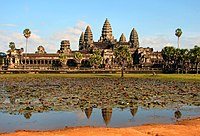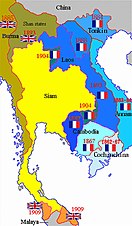柬埔寨历史
 柬埔寨历史系列条目 | ||||||||||||
|---|---|---|---|---|---|---|---|---|---|---|---|---|
| 扶南 约1世纪–550 | ||||||||||||
| 真腊 约6世纪–802 (水真腊、陆真腊) | ||||||||||||
| 高棉帝国 (吴哥时期) 802–1431 | ||||||||||||
| 金边时期 1431–1525 | ||||||||||||
| 洛韦时期 1525–1593 | ||||||||||||
| 斯雷桑托时期 1594–1620 | ||||||||||||
| 乌栋时期 1620–1863 | ||||||||||||
| 越南统治时期 1835–1847 | ||||||||||||
| 法国统治时期 1867-1953 | ||||||||||||
| 日本占领时期 1941-1945 | ||||||||||||
| 第一王国 1953-1970 | ||||||||||||
| 高棉共和国 1970-1975 柬王国民族团结政府 | ||||||||||||
| 民主柬埔寨 1976-1979 | ||||||||||||
| 民柬联合政府 1979-1992 |
柬埔寨 人民共和国 1979-1992 | |||||||||||
| 联柬权力机构 1992-1993 | ||||||||||||
| 柬埔寨王国 1993至今 | ||||||||||||
柬埔寨是中南半岛地区历史悠久的文明古国,有两千年以上之历史,其历史可以追溯到印度文明[1][2]。柬埔寨有详细记录以来最早出现、曾被中国史册提及的是扶南国-一个在公元1至6世纪围绕中南半岛最南端的政体。扶南国被认为有着南湄公河一带[3]最古老的区域印度教文化,这显示了其在印度圈中的角色,为西边印度的长期海上贸易伙伴[4]。到了6世纪,在中国史册中被称为真腊的另一个文明崛起,取代了扶南国,控制着中南半岛更大、更起伏的地区,并且保持了不仅仅一个权力中心[5][6]。
高棉帝国成立于9世纪初。传说中于公元802年,高棉帝国的开国君主阇耶跋摩二世在库楞山借着神话启示和神圣化的仪式,主张其政治合法性。继承著印度神王崇拜传统的强大主权统治了高棉文明的古典时代,直到11世纪。据一些学者称,后期的省级引进了佛教,导致了皇家宗教的断绝和衰落[7]。高棉帝国的皇室结束于14世纪,其中高棉帝国在行政、农业、建筑、水文、物流、城市规划和艺术,皆是创新和进步的文明的见证,是东南亚历史文化遗产的基石[8]。
柬埔寨的衰落持续了大约100年,随后是15世纪中叶开始的柬埔寨历史中期,是为柬埔寨黑暗时代。虽然当时的印度教文化已全部被取代,但旧首都的遗址仍然是重要的精神中心[9]。然而,自15世纪中叶以来,柬埔寨核心人口续渐向东迁移,其中只有少数例外-定居在湄公河的合流处,以及洞里萨湖周边的金边、洛韦和乌栋[10][11]。
海洋贸易是16世纪繁荣的基础,但与此同时,柬埔寨受到外地人的干扰和影响亦不断增加,其中包括马来人穆斯林、占族人,基督徒欧洲冒险家和传教士。模棱两可的命运,一方面带来强势的经济发展,另一方面亦导致文化的混乱和削弱的王权,是洛韦时期 的常有特征[12][13]。
在15世纪,本来高棉人的相邻部族,包括西部的孟族和东部的占族逐渐淡落,或是分别被更坚韧的泰族和越族取替[14]。各强权已意识到,要全面控制中南半岛,控制湄公河下游盆地尤其重要。虚弱的高棉王国成为了阿瑜陀耶王国(即后来的曼谷)和占城战略家的众矢之的。对高棉王室的攻击和征服使主权者在表面和实际上皆失去了权力的基础[15][16]。对继承和婚姻政策的干涉加剧了皇家威望的衰落。公元1601年,乌栋时期开始,是柬埔寨中世纪的最后一个时期[17]。
至19世纪,当时技术更先进且野心勃勃的欧洲殖民大国,开始涉足东南亚。另一边厢的拉达那哥欣王国,虽有遭到侮辱和并持续撤退,最终因作为英法殖民地之间的缓冲而逃过一劫。而越南则成为了法国征服对象[18] [19]。柬埔寨虽在很大程度上被忽略了,[20]但亦同样作为一个可感知的实体加入法属印度支那,并将其身份和完整性重新纳入现代[21][22]。
在经历了80年的殖民“冬眠”后,日本于第二次世界大战期间短暂占领柬埔寨,那时也巧合是柬埔寨国王诺罗敦·西哈诺的授衔仪式[23],成为柬埔寨重新解放和其现代历史不可逆转过程的开端。公元1953年,柬埔寨王国独立,并在美、苏两极分化的世界中努力保持中立[24]。随着越战升级,柬埔寨越来越多地涉及其中[25],1970年高棉共和国的建立是其中的一个结果。1975年,赤柬政权在柬埔寨内战获胜,取代了共和国,柬埔寨踏入最黑暗的时代[14],柬越战争亦为柬埔寨带来毁灭性影响。1993年,柬埔寨人民共和国在联合国协议下向现代柬埔寨迈进[26]。
史前和早期历史
[编辑]现时对于柬埔寨早期的历史所知有限,目前根据放射性碳测年结果所得,柬埔寨最早约在公元前4200年已有人类居住。在柬埔寨西北部马德望省的罗恩司拼,该地在洞穴生活的人类会使用石器、陶器等工具。[27][28][29]自2009年起,“法柬史前考察团”的考古研究已经记录了距今7.1万年前到洞穴新石器时代的完整文化序列[30]。自2012年以来的发现得到了普遍的解答,该洞穴留下了猎人和狩猎团体首次占领的考古遗迹,亦发现了新石器时代的人类,他们具有高度发达的狩猎策略和制作石器的技术、高超的陶艺制作技术,以及复杂的社会、文化、象征和殡葬习俗[31]。柬埔寨曾参与海上玉路长达3000年,该路径始于大约公元前2000年至1000年左右[32][33][34][35]。
在磅清扬省的山隆生(Samrong Sen)发现了公元前1500年的头骨和人骨。Heng Sophady (2007)将山隆生与柬埔寨东部的圆形土壤遗址进行了比较。这些人是可能从中国东南部迁移到中南半岛。学者们追溯了他们首次种植水稻和东南亚首次制作青铜的历史[36]。
2010年,在柬埔寨西北部的Phum Snay墓地的骨骼材料检验中发现了异常高的伤害数量,特别是头部,很可能是由人际暴力引起的。坟墓里还包含大量在冲突中使用的剑和其他攻击性武器[37]。
东南亚的铁器时代始于公元前500年左右,一直持续到约公元500年-扶南时代的结束,它提供了与印度和南亚的持续海上贸易和社会政治互动的第一手具体证据。到了公元1世纪,定居者已发展出了复杂的有组织社会和各种宗教及宇宙观,这需要与当今的语言非常相关、高度进化的口语。最先进的群体居住在沿海地区、湄公河下游、以及三角洲地区的高脚房屋中,他们会种植稻米、捕鱼、并会饲养家畜[3][38][39][40]。
扶南王国(1世纪-550/627年)
[编辑]
中国史籍[41]详细记录了第一个已知的有组织政治实体——扶南王国,为于现时柬埔寨和越南的领土上,有着“人口众多、城市中心、粮食生产过剩……社会政治分层[并]以印度宗教思想为合法化基础”为特点[42][43]。从公元1世纪到6世纪,扶南以湄公河和巴萨河下游地区一个拥有“护城墙及护城河的城市”为中心[44],如柬埔寨茶胶省的吴哥波雷和位于现今越南安江省的俄厄。
早期的扶南由松散的社群组成,每个社群都有自己的统治者,并通过共同的文化和共用的经济联系在一起。内陆地区的稻米种植者与沿海城镇的商人,两者在经济上相互依存,使生产过剩的稻米得以输出至港口[45]。
到了公元2世纪,扶南控制了中南半岛的战略海岸线和海上贸易路线。文化和宗教思想通过印度洋贸易路线传入扶南。早在公元前500年左右,印度就与扶南进行了贸易往来。当时,梵语还没有取代巴利语[4]。扶南的语言被认为是早期的高棉语,并以梵语为书写形式。[46]


公元 245 年至 250 年期间,东吴官员出使扶南的毗耶陀补罗[47][48]。中郎康泰、宣化从事朱应将扶南定义为一种独特的印度教文化[49]。扶南与中国的贸易是在汉朝南扩之后开始的,在大约公元前2世纪,扶南实际上“控制着除沿海地区之外的战略陆路通道”[50],并在为印度洋贸易,现今被称为海上丝绸之路之间的“经济和行政枢纽”[51][52]占据着显著的地位。远至罗马的贸易路线得到了第2、第3世纪定居点的遗址的出土罗马、波斯硬币,和出土文物证实[3][53]。
扶南与神话有关,例如Kattigara传说和高棉建国传说,其中一名在《梁书》中记载为混填(高棉语中名为Preah Thaong、梵语中为Kaundinya)的印度婆罗门或王子,迎娶了当地的统治者那姬‧绍玛公主(梁书中记载为柳叶),从而建立了第一个柬埔寨君主王朝[54]。
学者们对于这个叙述在多大程度上属实,以及Kaundinya的起源和地位存在争议[55][56]。 当代的资料来源包括一份经过四次修改的中国文献[57]和一份三世纪的占婆铭文[58]。一些学者认为这个故事只是印度教和佛教用来向古代当地传播宇宙观和文化的寓言[59] 而一些历史学家则从时间顺序上否定它[60]。
中国史书纪载在公元3世纪初期,扶南的领土在范师蔓的统治下达到巅峰,南至马来西亚,西至缅甸。商业垄断中的重商主义制度得以建立。出口产品从森林产品到贵金属和商品,如黄金、大象、象牙、犀牛角、翡翠羽毛、豆蔻、漆、皮革和芳香木材。在范师蔓的统治下,扶南拥有一支强大的舰队,并由一个基于“朝贡经济”的先进官僚制度管理,所得的盈余用于支持沿海的外国商人,表面上用于发起向西和向南的扩张任务[3]。
历史学家对扶南的政治地位和完整性持有相互矛盾的观点[61]。Miriam T. Stark称之为扶南:“扶南作为早期‘国家’的概念…大部分是由历史学家利用文献和历史证据建立的”,麦可·维克里评论道:“尽管如此,它是…不太可能凭这几个港口就构成一个统一的国家,更不用说一个‘帝国’了”[62]。不过,其他消息来源也暗示了其帝国地位:“附庸王国向东扩展至越南南部,又扩展至西部的马来半岛”[63];“在这里我们将看到这一时期的两个帝国…扶南和三佛齐”[64]。
扶南如何终结的问题在学术界普遍存在争议。扶南的继承者称为真腊,于公元616/617年在《隋书》中首次出现。
考古学方法和对整个早期历史时期的解释被认为是未来研究的关键补充[69]。“湄公河下游考古项目”专注于早期历史时期该地区政治复杂度的发展。例如,2003年至2005年的LOMAP调查结果有助于确定“…该地区的重要性在整个前吴哥时期持续不减…而且至少有三个(调查区域)具有吴哥王朝时期的日期,并表明三角洲地区的持续重要性[3]。”
真腊王国(6世纪-802年)
[编辑]《隋书》记载了一个名为真腊王国的国家在616或617年派遣使节前往中国,声称真腊原是扶南的附庸国,但在其统治者摩诃因陀罗跋摩的领导下,征服了扶南并获得了独立[70]。
自从1970年代以来,大部分有关真腊的中国记载,包括真腊征服扶南的记载,一直备受争议,因为它们通常基于中国历史记载中的单一记述,正如作者克洛德·雅克所强调的那样,中文术语“扶南”和和“真腊”的含义非常模糊,而更多的国内碑文资料已经出现。克洛德·雅克总结道:“由于历史学家们更多是基于中国的记录,而不是基于[柬埔寨]铭文地重建了前吴哥时期的柬埔寨历史”,因此是“做了非常基本的历史错误”,而当新的铭文被发现时,研究人员“更喜欢将新发现的事实调整到最初的轮廓上,而不是质疑中国的报告”[71]。
关于真腊的中心在现代老挝的观点也受到了争议。“只需要它在扶南的内陆即可”[72]。吴哥时代之前柬埔寨最重要的政治记录,是公元667年来自巴布农的K53铭文,无论是在国王留陀跋摩、拔婆跋摩一世、摩诃因陀罗跋摩、伊奢那跋摩一世和阇耶跋摩一世的王位继承,还是在制造铭文的官员家族的地位上,皆末显示有任何政治断层。几年后公元来自公元674年的另一个铭文K44,纪念在亨得喜省的一个基金会,在阇耶跋摩一世的赞助下成立,提到Raudravarma时代早期基金会,这大概是指扶南的陁跋摩国王,亦没有任何政治中断的迹象。
《唐书》记载公元706年后以后,真腊分裂为陆真腊和水真腊。这些名称表示为南北两部分,亦可称为上下真腊[73]。
到了8世纪末,水真腊已成为爪哇的夏连特拉王朝的附庸国——其最后的国王被杀,该政权在公元790年左右被并入爪哇王室。陆真腊在公元802年由阇耶跋摩二世获得独立[74]。
扶南的附庸国吴哥王国经由门河河谷从北部湄南河抵达湄公河。真腊是他们在扶南的影响外的第一个独立国家[75]。
古代中国记载提到了两位国王——Shruta Varman和Shreshtha Varman II,统治着位于现时老挝南部的首都Shreshthapura。巴瓦普拉高棉王国(位于现代柬埔寨城市磅同市)对柬埔寨的身份认同产生了巨大影响。其最重要的君主是伊奢那跋摩一世,在612-628年间完全征服了扶南王国。他在三博波雷古寺建立了新的首都,并将其命名为伊奢那城[76]。
高棉帝国(802年-1431年)
[编辑]
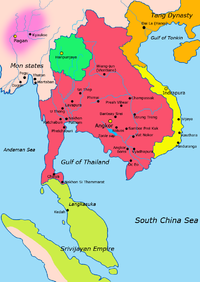
跨越六个世纪的高棉帝国拥有无与伦比的技术、艺术造诣和成就、政治完整和行政稳定,代表着柬埔寨和东南亚前工业文明的文化和技术顶峰[77]。
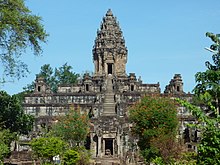
高棉帝国继承自真腊王国—一个权力中心不断变化的政体,在八世纪初分裂为陆真腊和水真腊。[78] 到8世纪末,水真腊被马来人的三佛齐以及爪哇人夏连特拉王朝并占[74] 。公元802年,真腊国的统治者阇耶跋摩二世在荔枝山发起印度教祝圣仪式,自任命为转轮王,宣布从夏连特拉王国和三佛齐独立。他建立了在吴哥地区的第一个首都诃利诃罗阿赖耶,位于现时罗洛士市附近[79]。
因陀罗跋摩一世(877-889年)及其儿子和继任者耶输跋摩一世(889-900年)建立了首都耶输陀罗补罗,并下令在首都北部修建巨大的水库(barays)。水利管理网络依赖于复杂的管道、池塘和堤坝配置,这些都是用大量的黏土沙子建造的,这都是吴哥平原上唾手可得的原材料。东大人工湖的堤坝至今仍然存在,长度超过7公里(4英里),宽度为1.8公里(1英里)。而西大人工湖则为最大的组成部分,是个长达大约8公里(5英里)、宽2公里(1英里)、含有约5000万立方米水的水库[80]。
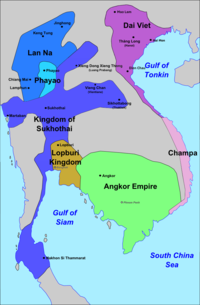
王室管理是基于湿婆派印度教国家的宗教理念和作为军阀和保护者的主权的中央崇拜 —“瓦尔曼”(Varman)。这种集中式的治理体系任命了王室官员管理各省。玛希达普拉王朝,起源于扁担山脉以西的门河河谷的第一任国王阇耶跋摩六世(1080-1107年)终止了旧的“仪式政策”、家谱传统、最重要的是,废除了以印度教作为排他性的国教。一些历史学家将这个帝国的衰落归因于这些宗教的不连续性[81][82]。
各个首都所覆盖的地区分散在约1,000平方公里(386平方英里)的区域内,现在通常被称为吴哥窟。基于工程灌溉系统的先进水稻农业,以及洞里萨湖丰富的鱼类和水生动物资源作为蛋白质来源,保证了长期的食物充盈供应。最近的地质勘测证实,吴哥窟在12世纪和13世纪期间保持着全球最大的前工业时期定居点群 - 大约有75万人居住在那里。大量的公共劳动力被重新分配到纪念碑建设和基础设施维护。越来越多的研究者将当地脆弱的生态系统和其资源的逐步过度开发,以及大规模的森林砍伐和由此导致的侵蚀作用与帝国的最终衰落联系起来。[83]
在国王苏利耶跋摩二世(1113-1150 年)的统治下,帝国的彊界达到了最大,直接或间接控制了印度支那、泰国湾和东南亚北部海域的大片地区。苏利耶跋摩二世委托建造的吴哥窟寺庙历时 37 年建成,其代表须弥山的五座塔楼被认为是古典高棉建筑最具典范的体现。然而,当苏利耶跋摩二世在试图入侵大越的战斗中被杀时,领土扩张亦随即终结。随后是一段王朝动乱和占婆入侵的时期,最终迎来 1177 年的吴哥洗劫。

阇耶跋摩七世国王(1181-1219 年在位)被普遍认为是柬埔寨最伟大的国王。作为一名大乘佛教徒,他在一次成功的战役中反击了占婆。在他近四十年的执政期间,他成为最多产的纪念碑建造者,他建立了吴哥城及其中央寺庙巴戎寺。他的其他杰出作品包括 斑黛喀蒂寺、塔布茏寺、龙蟠寺和皇家浴池。他建造了大量实际的世俗专案和建筑,例如维护苏利耶跋摩一世广泛的道路网络,特别是通往披迈的皇家道路以及许多休息站、桥梁和医院,使阇耶跋摩七世成为所有帝国统治者中独一无二的人物[84]。
1296年8月,元代外交官周达观到达吴哥并在因陀罗跋摩三世的宫廷逗留,直到1297年7月。他写了一份详细的报告《真腊风土记》,介绍了吴哥的生活。他的描绘是了解吴哥历史最重要的资料之一,因为这份文件提供了有关吴哥居民的日常生活和习惯的宝贵资讯[85]。
最后一份梵文铭文的日期是1327年,记录了因陀罗跋摩四世的继任者阇耶跋摩九世继位(1327–1336年在位)。
帝国是一个由精英、工人和奴隶三个社会阶层组成的农业国家。精英包括顾问、军事领袖、宫廷人员、僧侣、官员和官僚。工人包括农业劳动者和各种建筑工人。奴隶通常是来自军事战役或遥远村庄的俘虏。高棉没有铸币,以物易物的经济主要以稻米为首的农产品为基础,区域贸易在经济中占微不足道的地位。[86][87]
明宣德五年(1430年)暹罗入侵柬埔寨,包围吴哥城七个月,最后攻破吴哥。因为吴哥太靠近暹罗边境,柬埔寨放弃吴哥,迁都金边。
柬埔寨后吴哥时代(1431年-1863年)
[编辑]

“柬埔寨后吴哥时期”,又称为“中世纪时期”[88] 指的是从15世纪初到1863年柬埔寨成为法国保护国的历史时期。可靠的资料(尤其是在15至16世纪)非常稀少。对于高棉帝国具体的衰落原因至今仍未得出结论[89][90]。然而,现代大多数历史学家认为,宗教、王朝、行政和军事的逐渐变化、环境问题和生态失衡等因素[91],与印度支那权力转移同时发生,必须全面考虑才能做出解释[92][93] 。近年来,研究重心特别转向气候变化、人类与环境的互动以及生态后果[94][95][96][97]。
寺庙碑文结束于14世纪30年代,直到16世纪中期才重新开始。关于王朝的纪年记录在阇耶跋摩九世国王时期停止,有超过200年的时间没有任何当代纪录记录一位国王的名字。自阇耶跋摩七世统治后,纪念性的寺庙建筑建设已经停滞不前。根据作者Michael Vickery的说法,15世纪的柬埔寨只存在外部的来源资料纪绿,即中国明朝《明实录》和最早的大城王朝《皇家编年史》[98][99]。16世纪的中国学者王世贞曾说:“官方历史学家毫无拘束,擅长隐瞒真相,但他们记录的纪念碑和法令以及他们抄写的文件是不容忽视的[100][101]。”
整个15世纪的中心参考点是大约在1431年左右的暹罗入侵了耶输陀罗补罗(吴哥城)事件。历史学家将此事件与柬埔寨政治中心向南迁移到金边、洛韦和后来的乌栋有关[11][40]。
“随着暹罗成为吴哥灭亡后柬埔寨的主要敌人,它终结了柬埔寨在其西部边境的帝国实验所有效延续的矛盾主权模式。”[82]

16世纪的资料来源更丰富,该王国以湄公河流域为中心,作为亚洲海上贸易网络的一部分繁荣发展[102][103],并与欧洲探险家和冒险家有了第一次接触[104]。与暹罗的战争导致领土损失,至1594年首都洛韦被攻破。17世纪,越南南下行军到达湄公河三角洲的下高棉及西贡地区,自始柬埔寨渐渐失去海上贸易和独立海洋贸易的地位[105]。
此后柬埔寨国势衰败,备受越南侵略。1623年,越南阮朝获得柬埔寨国王的同意,在下高棉地区设立贸易机构。1697年越南灭亡占婆国,开始与柬埔寨接壤。1770年越南在下高棉地区站稳脚跟。1807年越南利用柬王安赞二世与暹罗的矛盾,重新确立越柬宗藩关系,使柬埔寨成为“属国”。1813年越南派兵进驻南荣(金边),柬成为保护国。
在17世纪和18世纪,暹罗和越南的主导地位上升,使得王权的频繁转移,柬埔寨王权降至附庸地位[106][107]。19世纪初,随着越南、暹罗王朝的牢固建立,柬埔寨被置于联合宗主权之下,失去了国家主权。英国特使约翰·克劳福表示:“…那个古老王国的国王已准备接受任何欧洲国家的保护…”为了拯救柬埔寨免于受越南和暹罗吞并,柬埔寨人吕宋人(Luzones)和卢科斯人(来自菲律宾吕宋岛的人)的援助,他们曾作为雇佣兵参加过暹缅战争。当代表团抵达吕宋时,统治者已经是西班牙人,所以他们也向西班牙人寻求援助,还有他们从墨西哥引进的拉丁美洲军队。以便在暹罗入侵被击退后,恢复当时已改信基督教的国王萨达二世作为柬埔寨君主的地位。然而,这只能暂时恢复短时间的主权。新君安东亦因为法国与西班牙的联盟关系(因为西班牙当时由法国波旁王朝家族统治),也请求法国的支援。柬埔寨国王诺罗敦同意法国的保护提议,并于1863年8月11日签署并正式承认法国的保护国地位。[108][109]
法国殖民时代(1863年-1953年)
[编辑]1863年8月,诺罗敦国王与法国签订保护条约,柬埔寨成为法国的保护国[40]。初期的条约保留了柬埔寨的高度主权,后来法国的控制逐渐加强,以1877年、1884年和1897年的尤其明显,直到世纪末,柬王于王宫外的王权已尽失[110]。诺罗敦国王于1904年去世,他的两位继任者西索瓦和蒙莫望皆支持法国殖民政权,然而法国于1940年在与泰国的一场短暂边境战争中被击败,被迫放弃了巴达木省和吴哥(吴哥古迹本身被保留)。蒙莫望国王于1941年4月去世[40],法国将默默无闻的西哈诺王子加冕为国王,认为这位经验不足的18岁年轻人比蒙莫望的中年儿子蒙润更加易于控制。
战争结束时,柬埔寨的局势混乱无序[40]。自由法国在戴高乐将军的领导下决心要收复印度支那,尽管他们为柬埔寨和其他印度支那保护国提供了一定程度的自治[40],但他们确信自己的“文明使命”,他们期望印度支那加入法国前殖民地联盟,共享法国文化的共同经验[111][40]。
西哈诺时期(1953年-1970年)
[编辑]1945年3月9日,在日本占领柬埔寨期间,年轻的国王诺罗敦·西哈诺在日本的正式请求下宣布柬埔寨王国独立。随后,日本政府名义上批准了柬埔寨的独立,并在金边设立了领事馆[112]。新政府取消了法国殖民政府开始强制执行的高棉语罗马化,并正式恢复了高棉文字。这一短暂政府当局采取的措施受到了广泛的欢迎和持久的影响,自那时起,柬埔寨政府再也没有试图将高棉语罗马化[113]。在盟军部队进入柬埔寨之后,驻扎在该国的日本军队被解除武装并遣返。同年10月,法国重新实行殖民统治[114]。


西哈诺的“皇家独立运动”导致法国勉强同意他的主权转移要求。部分协定于1953年10月达成。西哈诺随后宣布已经实现了独立,并凯旋回到金边。由于关于印度支那问题的日内瓦会议,柬埔寨得以使越南独立同盟会从其领土撤军,并抵制外部势力对其主权的任何残留侵犯。
在20世纪50至60年代,中立是柬埔寨外交政策的核心要素。到1960年代中期,柬埔寨东部省份的部分地区成为北越军队和民族解放阵线(NVA / NLF)对抗南越的基地,西哈诺市成了他们的供应港口。随着NVA / VC活动的增长,美国和南越变得担忧。1969年,美国开始了为期14个月,以NVA / VC为目标的轰炸行动,加剧了局势不稳。轰炸行动地点不超过柬埔寨边境的10英里(后来扩大到20英里),这些地区的柬埔寨人口已被北越军队驱逐[115]。西哈诺亲王担心共产主义北越和南越之间的冲突可能会波及到柬埔寨,公开反对美国在越柬边境和柬埔寨领土的轰炸行动。然而,彼得·罗德曼却声称“西哈诺亲王向我们苦怨在他国家的这些北越基地,又邀请我们攻击它们。”1967年12月,西哈诺告诉《华盛顿邮报》记者斯坦利·卡诺:如果美国想轰炸越南共产主义的庇护所,他不会反对,除非有柬埔寨人被杀害[116]。同样的资讯在1968年1月传达给了美国总统詹森的使者切斯特·鲍尔斯[117]。因此,美国没有真正的动机推翻西哈诺。然而,西哈诺亲王希望柬埔寨远离两越冲突,并对美国政府及其盟友(南越政府)持批评态度。西哈诺亲王自己亦因赤柬党的崛起而面临内部斗争,故不想再让柬埔寨卷入另一场冲突。西哈诺亲王希望美国及其盟友(南越)将战争远离柬埔寨边境,亦不允许美国将柬埔寨领空和机场用作军事目的。这让美国非常不满,并促使他们认为西哈诺亲王是北越的同情者和美国的眼中钉[118]。然而,解密档表明,直到1970年3月,尼逊政府仍希望与西哈诺亲王建立“友好关系”。
在20世纪60年代,柬埔寨国内政治逐渐极化。中产阶级和左派人士,包括巴黎受过教育的领导人宋成、英萨利和萨尼奥尔特绍(后来被称为波博),在秘密的柬埔寨共产党(CPK)的领导下发动了一场起义。西哈诺称这些起义者为赤柬。但是,1966年的全国议会选举明显倾向右派,朗诺将军组建了一届新政府,一直持续到1967年。在1968至1969年期间,起义活动恶化。然而,政府和军队成员对西哈诺的统治方式以及他对美国的倾斜感到不满,确实有推翻他的动机。
高棉共和国(1970年-1975年)与内战
[编辑]
1970年,当西哈诺访问北京时,总理朗诺将军和西索瓦·施里玛达亲王在1970年3月18日凌晨发动了一次军事政变,推翻了西哈诺政权[119][120]。然而,早在1970年3月12日,美国中央情报局局长就告诉华盛顿,根据朗诺的表弟施里玛达的通讯,“(柬埔寨)军队已准备好发动政变”[121]。朗诺在军事政变后上台,并随即与美国结盟。波博的反对者山玉成立即宣布支持新政府。10月9日,柬埔寨君主制度被废除,国家更名为高棉共和国。新政权立即要求越南共产党人离开柬埔寨。
河内拒绝新共和国要求撤出北越军队的请求。作为回应,美国向新政府的武装部队提供物资援助,这些部队同时对抗赤柬游击队和北越军队。北越和越共军队为了保持他们从北越进入柬埔寨的庇护所和补给线,便立即对新政府发动武装攻击。北越军队迅速占领了柬埔寨东部的大片领土,距离金边仅有24公里。北越把新获得的领土交给了赤柬。国王敦促他的追随者帮助推翻这个政府,加速了内战的爆发。[122]

1970年4月,美国总统理查·尼逊向美国公众宣布,美国和南越地面部队已进入柬埔寨,旨在摧毁越南人民军在柬埔寨的根据地(见入侵柬埔寨)[123]。此前美国已轰炸了柬埔寨境内的越南军队根据地超过一年。虽然美国和南越部队缴获、摧毁了相当数量的装备,但对北越军队的遏制却难以实现。
高棉共和国的领导人受到共和国三位主要人物之间分歧的困扰:朗诺、西哈诺的表弟西索瓦·施里玛达和国民议会领袖英丹。朗诺仍然掌权,因为没有人愿意取代他。1972年,宪法获得国民议会批准,朗诺就任总统。相反,3万人军队转为超过20万人国家作战力量以及腐败的猖獗的不团结,削弱了民政和军队。

在北越的补给和军事援助的帮助下,柬埔寨的共产主义叛乱继续增长。波博和英萨利声称他们镇压在越南训练的共产党人,其中大多数人被清洗。与此同时,柬埔寨共产党的势力变得更强大,开始独立于越南的帮助。1973年,柬埔寨共产党在北越很少或根本没有援助的情况下对政府军发动战争,并控制了近60%的柬埔寨领土和25%的人口。
政府曾试图与叛乱分子进行三轮谈判但均未成功,相反,1974年,柬埔寨共产党通过大师进行公开军事行动,部分北越作战部队转移到南越。朗诺的控制范围缩小到靠近城市和主要交通车道的较小郊区。超过200万难民逃离战争并定居在金边和其他城市。
1975年元旦,共军发动了长达117天的激烈攻势,推翻了高棉共和国。赤柬军在金边周围同时发动攻击,围攻了共和军队,而各赤柬部队亦突袭并纵火焚烧了控制湄公河下游主要地区补给线的几个军事基地。由美国资助的弹药和大米空运在国会拒绝其为柬埔寨提供额外援助后结束。1975年4月17日,金边的朗诺政府投降,金边沦陷,此时距美国代表团从柬埔寨撤军仅五天[124]。
外国势力参与红色高棉的崛起
[编辑]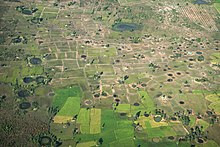
美国对柬埔寨的大规模地毯式轰炸与红色高棉在征兵和民众支持方面的发展之间的关系一直是历史学家感兴趣的问题。一些历史学家,包括叶礼庭、亚当·琼斯[125]和格雷格·格兰丁[126],将美国的干预和轰炸行动(1965-1973年)视为导致柬埔寨农民对红色高棉支持增加的一个重要因素[127]。本·基尔南表示,红色高棉“不可能在美国没有破坏柬埔寨的经济和军事稳定的情况下赢得政权…它利用爆炸事件对平民的破坏和屠杀作为征兵宣传,并以之作为其残暴、激进的政策,以及其暴力清洗温和共产主义者和西哈诺主义者的借口[128]。”波博的传记作者大卫·P·钱德勒写道,这些轰炸“达到了美国人期望的效果——它阻断了共产党对金边的包围”,但亦加速了农业社会的崩溃,加剧社会两极分化[129][130][131]。彼得·罗德曼和麦克·林德声称,美国的干预使朗诺政权免于 1970 年和 1973 年的崩溃[132][133]。克雷格·艾契逊认为美国的干预增加了红色高棉的征兵人数,但对其是否引致红色高棉胜利的首要原因表示质疑[134]。威廉·肖克罗斯写道,美国的轰炸和地面入侵使柬埔寨陷入了西哈诺多年来努力避免的混乱[135]。
至1973年,越南对红色高棉的支持已基本消失[136]。中国在内战期间及其后几年为红色高棉提供“武装和训练”[137]。
在中、美和西方的支持下,红色高棉主导的民主柬埔寨联合政府(CGDK)一直保持着柬埔寨的联合国席位,直到冷战结束很久之后的1993年[138]。中国捍卫与红色高棉的关系。中国外交部发言人姜瑜表示,“民主柬埔寨政府在联合国拥有合法席位,并与70多个国家建立了广泛的外交关系”[139]。
民主柬埔寨(红色高棉时期)(1975年-1979年)
[编辑]

柬埔寨共产党在取得胜利后,随即下令疏散所有城镇,将整个城市人口迁往农村当农民[140],试图按照波博开创的模式进行社会改革。
新政府试图完全重组柬埔寨社会。旧社会被废除,宗教特别是佛教和天主教受到压制[141][142]。农业收归公有,主要工业被放弃或被国家控制。当时柬埔寨既没有货币也没有银行体系。
由于边境冲突和意识形态差异,民主柬埔寨与越南和泰国的关系急剧恶化。高举极端高棉民族主义的赤柬党人清洗了大部分居住在越南的党员。因此大多数曾在越南生活的党员皆面临清洗了。民主柬埔寨与中华人民共和国建立了密切联系,其中柬越冲突成为中苏敌对关系的一部分(莫斯科支持越南)。随着民主柬埔寨军队袭击越南村庄,边境冲突进一步恶化。最终赤柬政权于1977年12月中与越南断交,以抗议越南据称建立印度支那联邦。1978年中期,越南军队入侵柬埔寨,在雨季来临前推进约48公里。
对于1975年至1979年间实际死亡人数的估计是合理的,但可能有数十万人被杀、数十万人死于饥饿和疾病(无论是在柬埔寨共产党的领导下还是在1978年越南入侵期间)。鉴于1975 年人口估计为730万,一些人估计死亡人数为100万至300万。中央情报局估计,1975年至1979年间,仅国家清洗就有50万至100万人被杀害,而红色高棉则杀害了150 万人(120万至180万人)[143]。
中国支持柬埔寨共产党的原因是为了防止泛印度支那运动,并维持中国在当地的军事优势。苏联支持强大的越南,以保持对抗中国的第二战线,并防止进一步的中国扩张。自斯大林去世以来,毛泽东控制下的中国与苏联之间的关系冻结。1979年2至3月,中国和越南因此问题爆发短暂的中越战争。
1978年12月,越南宣布成立柬埔寨救国民族团结阵线(KUFNS)[40],由前民主柬埔寨军队的指挥官韩桑林领导。它由1975年后留在越南的赤柬党人和1978年从柬埔寨逃到越南的东部官员(如韩桑林和洪森)组成。1978年底,越南军队全面入侵柬埔寨,并于1979年1月7日占领金边,并将民主柬埔寨军队的残部向西驱赶到泰国。
柬埔寨共产党是由曾在巴黎接受教育的领导层掌控,包括波博、英萨利、农谢和宋成。1976年1月的新宪法确立了民主柬埔寨为共产主义人民共和国,并于3月选出了由250名成员组成的柬埔寨人民代表大会(PRA),选举国家主席团的集体领导人,其中主席为国家元首。
西哈诺亲王于4月2日辞去元首职务[40]。4月14日,柬埔寨人民代表大会在第一次会议结束后宣布由乔森潘担任国家主席,任期5年。议会选举波博为首的15名内阁成员担任总理。西哈诺亲王实际上被软禁。
政权造成的破坏和死亡
[编辑]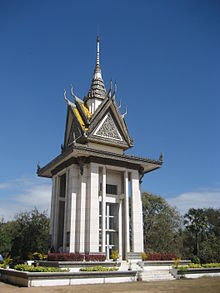
在疏散金边及其后续事件期间,有20,000人因疲惫或疾病而死亡。许多被迫撤离城市的人被重新安置在新建的村庄里,那里缺乏食物、农具和医疗服务。由于残酷的疏散,数千人在疏散过程中挨饿或死于疾病。他们中的大多数人被迫离开城市,定居在新建立的村庄,缺乏食物、农业设备和医疗保健。一些过往的城市居民在农业环境中失去了生计。在第一次收获前,成千上万的人处于挨饿。饥饿和营养不良——几乎达到饥饿的程度——在那些年里经常发生。大多数泄露个人资历秘密的前政权军事和中央政府领导人都被处决。
柬埔寨的一些民族,例如占族和越南族,遭受了特殊而有针对性的暴力迫害,甚至一些国际消息人士将其称为“占族种族灭绝”。整个家庭和城镇都成为攻击目标,目的是大幅减少并最终消灭他们[1] 互联网档案馆的存档,存档日期2012-07-19.。 在“赤柬政权”下的生活十分严峻而残酷。人们因讲外语、戴护目镜、寻找食物,甚至哀悼亲人的尸体而被动员和处决。红色高棉担心前商人及政府官员会领导反政权起义,因此他们以及其所有家人都会遭到追捕和杀害。由于未有抓到并处决足够多的反革命分子,少数红色高棉效忠者同样被杀害。

当柬埔寨社会主义者开始在柬埔寨东部地区叛乱时,波博命令他的军队消灭150万柬埔寨东部人[144],他将这些地区人士称为“具有越南思想的柬埔寨人”。清洗行动迅速而有效,波博的士兵在一个月内将至少超过10万至25万柬埔寨东部人,驱逐到中部、北部和西北地区的刑场后,迅速杀害了他们[145],这成为了波博政权下最血腥的大屠杀事件。
宗教机构也未能幸免于红色高棉,宗教事实上受到极为残酷的迫害,以至于柬埔寨绝大多数历史建筑,即柬埔寨95%的佛教寺庙被完全摧毁[146]。
本·基尔南估计,有167.1万至187.1万柬埔寨人因红色高棉政策而死亡,占柬埔寨1975年人口的21%至24%[147]。法国人口学家Marek Sliwinski的一项研究计算出,1975 年柬埔寨人口为780万,而在红色高棉统治下非正常死亡人数略低于200万;33.5%的柬埔寨男性死于红色高棉统治下,而柬埔寨女性的比例为15.7%[148]。根据2001年的一份学术资料,红色高棉统治下的超额死亡人数最被广为接受的估计在150万到200万之间,但也有提到低至100万、高至300万的数字;传统估计的死亡人数大约在50万到100万人之间,“是这一时期超额死亡率的三分之一到二分之一”[149]。然而,2013年的学术消息来源(援引2009年的研究)表明,处决可能占总数的60%之多,在23,745个乱葬坑中埋藏着大约130万名疑似处决受害者[150]。虽然远高于早期和更广泛接受的红色高棉处决估计,柬埔寨文献中心 (DC-Cam) 的克雷格·艾契逊为红色高棉处决人数超过 100 万的估计数字辩护称,“考虑到乱葬坑的性质和DC-Cam的方法更有可能低估死亡人数,而不是高估,实属合理”[138]。人口学家Patrick Heuveline估计,1970年至1979年间,有117万至342万柬埔寨人非正常死亡,其中15万至30万死于内战期间。Heuveline的中心估计有252万人超额死亡,其中140万人是由直接暴力造成的[149][138]。红色高棉的继任政权柬埔寨人民共和国公布的死亡估计为330万人,即使这数据是基于对柬埔寨人的挨家挨户调查,但仍被普遍认为是夸大其词;除其他方法错误外,柬埔寨人民共和国当局将在部分挖掘的乱葬坑中发现的受害者估计人数添加到原始调查结果中,这意味着一些受害者可能被重复计算[138]。
1979年至1980年间,估计有30万柬埔寨人饿死,主要是红色高棉政策的后遗症所造成[151]。
越南占领和柬埔寨人民共和国(1979年-1993年)
[编辑]
1979年1月10日,越南军队和柬埔寨救国民族团结阵线入侵柬埔寨,推翻了红色高棉政权,由洪森担任国家元首的柬埔寨人民共和国成立。波博的红色高棉军队迅速撤退到靠近泰国边境的丛林中。红色高棉和柬埔寨人民共和国开始了一场代价高昂的斗争,这对中国、美国和苏联等大国有利。柬埔寨人民革命党的统治引发了三个主要反抗组织的游击运动,包括FUNCINPEC(争取柬埔寨独立、中立、和平与合作民族团结阵线)、KPLNF(高棉人民全国解放阵线)和PDK(民主柬埔寨党,由在名义上担任主席的乔森潘领导的红色高棉)[152]。“所有这些组织对柬埔寨未来的目标和方式皆持有不同意见”。内战使60万柬埔寨人流离失所,逃往泰国边境的难民营,数以万计的人在全国范围内遭到杀害[153][154][155]。
1989年,柬埔寨政府与反对派团体之间的和平谈判于巴黎展开,并在两年后的1991年10月达成了全面和平协议。联合国获得了强制停火、处理难民和裁军的授权,被称为柬埔寨过渡时期联合国权力机构(UNTAC)。
现代柬埔寨(1993年-现在)
[编辑]
1991年10月23日,巴黎会议重新开幕,签署了一份全面协议,授权联合国全面监督停火,撤回在泰国边境的流离失所的高棉人,解除和遣散派系军队,为国家的自由公正选举做好准备。时任柬埔寨最高国民委员会(SNC)主席的西哈诺王子和其他国民委员会成员于1991年11月回到金边,开始在柬埔寨进行移民安置流程[156]。同时,联合国柬埔寨先遣部队(UNAMIC)也开始部署,维持各方之间的联系,并开始进行扫雷行动,以加快从泰国遣返约37万名柬埔寨难民[157][158]。
1992年3月16日,柬埔寨过渡时期联合国权力机构(UNTAC)抵达柬埔寨并开始实施联合国解决方案,并于同年3月15日正式运作,由联合国秘书长特派代表明石康担任特别代表[159][160]。UNTAC发展成为一支由2.2万名平民和军事维和人员组成的部队,负责确保选民自由公正地进行议会选举[161]。

1993年5月,超过400万名柬埔寨人(约90%的合格选民)参加了选举。据UNTAC称,选前暴力和恐吓行为相当普遍,主要是由前柬埔寨共产党干部组成的柬埔寨国家政府(SOC)安全部队对FUNCINPEC和BLDP两个政党进行的[162][163]。民主柬埔寨党(民柬)的武装势力实际上没有被解除武装或遣散,阻止当地人进入投票站[164]。奉辛比克党的诺罗敦·拉那烈亲王最高票得主,获得45.5%的选票,其次是洪森的柬埔寨人民党和自由民主佛教党。奉辛比克党随后与其他参加选举的政党组成了联合政府。由柬埔寨人民党和奉辛比克党组成的联合政府产生了两位共同首相 - 洪森和诺罗敦·拉那烈[165]。
代表120名议员的政党随后草拟并批准了一部新宪法,于1993年9月24日公布实施。该宪法在君主立宪的框架下建立了一个多党制自由民主国家,原王子西哈诺再次即位为王。诺罗敦亲王和洪森成为柬埔寨政府的第一和第二位首相。宪法规定了一系列国际公认的人权[166]。
然而,柬埔寨现任总理洪森和他的政府一直存在争议。洪森曾是红色高棉的指挥官,最初是由越南人任命上台的,在越南人离开后使用暴力和压迫镇压反对派和批评者,以维持其强势地位[167]。在1997年,他为了担心其联合首相诺罗敦·拉那烈的日益增长的权力,使用军队发动政变,驱逐了拉那烈和其支持者。拉那烈被驱逐并逃往巴黎,而洪森的其他反对者则被逮捕、折磨和有些被处决[167][168]。
在2004年10月4日,柬埔寨国民议会批准了与联合国签署的协议,成立一个法庭审判红色高棉负责暴行的高层领导人[169]。国际捐助国家承诺提供三年法庭预算中的4300万美元,而柬埔寨则贡献了1330万美元。自2008年以来,法庭已经判处了几位红色高棉的高层领袖[170]。目前,柬埔寨还正在清除红色高棉和越南人在几十年的战乱和动荡期间埋设的地雷,柬埔寨花了大约十年的时间才清除了大量地雷[171]。
柬埔寨救国党在2018年柬埔寨大选前被解散,统治的柬埔寨人民党亦对大众媒体实施更严格的限制[172]。柬埔寨人民党在没有主要反对派的情况下赢得了国民议会的所有席位,从而有效地巩固了该国的事实上一党统治[173][174]。
柬埔寨长期的总理洪森是世界上任期最长的领导人之一,他对权力有着非常牢固的掌控。他被指责镇压反对者和批评者。他的柬埔寨人民党自1979年以来一直执政。2021年12月,洪森总理宣布支持他的儿子洪玛奈接替他的职位,预计于2023年举行的下一届选举后继任[175]。
参见
[编辑]参考资料
[编辑]- ^ Chandler, David. Cambodian History: Searching for the Truth. Cambodia Tribunal Monitor. Northwestern Primary School of Law Center for International Human Rights and Documentation Center of Cambodia. July 2009 [2015-11-25]. (原始内容存档于2020-10-19).
We have evidence of cave dwellers in northwestern Cambodia living as long ago as 5000 BCE.
- ^ Mourer, Cécile; Mourer, Roland. The Prehistoric Industry of Laang Spean, Province of Battambang, Cambodia. Archaeology & Physical Anthropology in Oceania (Oceania Publications, University of Sydney). July 1970, 5 (2): 128–146. JSTOR 40386114.
- ^ 3.0 3.1 3.2 3.3 3.4 Stark, Miriam T. Pre-Angkorian Settlement Trends in Cambodia's Mekong Delta and the Lower Mekong Archaeological Project (PDF). Bulletin of the Indo-Pacific Prehistory Association. 2006, 26: 98–109 [2015-07-05]. doi:10.7152/bippa.v26i0.11998. hdl:10524/1535. (原始内容 (PDF)存档于2015-09-23).
The Mekong delta played a central role in the development of Cambodia’s earliest complex polities from approximately 500 BCE to 600 CE... envoys Kang Dai and Zhu Ying visited the delta in the mid-3rd century CE to explore the nature of the sea passage via Southeast Asia to India ... a tribute-based economy, that ... It also suggests that the region’s importance continued unabated
- ^ 4.0 4.1 Stark, Miriam T.; Griffin, P. Bion; Phoeurn, Chuch; Ledgerwood, Judy; et al. Results of the 1995–1996 Archaeological Field Investigations at Angkor Borei, Cambodia (PDF). Asian Perspectives (University of Hawai'i-Manoa). 1999, 38 (1): 7–36 [2015-07-05]. (原始内容 (PDF)存档于2015-09-23).
the development of maritime commerce and Hindu influence stimulated early state formation in polities along the coasts of mainland Southeast Asia, where passive indigenous populations embraced notions of statecraft and ideology introduced by outsiders...
- ^ "What and Where was Chenla?", Recherches nouvelles sur le Cambodge (PDF). Michael Vickery’s Publications. [2015-07-05]. (原始内容存档 (PDF)于2015-12-20).
- ^ Considerations on the Chronology and History of 9th Century Cambodia by Dr. Karl-Heinz Golzio, Epigraphist - ...the realm called Zhenla by the Chinese. Their contents are not uniform but they do not contradict each other. (PDF). Khmer Studies. [2015-07-05]. (原始内容 (PDF)存档于2015-05-24).
- ^ The emergence and ultimate decline of the Khmer Empire - Many scholars attribute the halt of the development of Angkor to the rise of Theravada...p.14 (PDF). Studies Of Asia. [2016-07-24]. (原始内容存档 (PDF)于2020-06-20).
- ^ Khmer Empire. The Ancient History Encyclopedia. [2015-07-07]. (原始内容存档于2020-12-06).
- ^ AN EIGHTEENTH CENTURY INSCRIPTION FROM ANGKOR WAT by David P. Chandler (PDF). The Siam Society. [2015-06-29]. (原始内容存档 (PDF)于2019-08-03).
- ^ Kingdom of Cambodia – 1431–1863. GlobalSecurity. [2015-06-12]. (原始内容存档于2019-07-21).
- ^ 11.0 11.1 Ross Marlay; Clark D. Neher. Patriots and Tyrants: Ten Asian Leaders. Rowman & Littlefield. 1999: 147. ISBN 978-0-8476-8442-7.
- ^ Murder and Mayhem in Seventeenth Century Cambodia. Institute of Historical Research (IHR). [2015-06-26]. (原始内容存档于2018-10-17).
- ^ Maritime Trade in Southeast Asia during the Early Colonial Period ...transferring the lucrative China trade to Cambodia... (PDF). Oxford Centre for Maritime Archaeology University of Oxford. [2015-06-26]. (原始内容存档 (PDF)于2018-04-23).
- ^ 14.0 14.1 Ben Kiernan. Blood and Soil: Modern Genocide 1500-2000. Melbourne Univ. Publishing. 2008 [2020-06-20]. ISBN 978-0-522-85477-0. (原始内容存档于2016-05-29).
- ^ 1551 – WAR WITH LOVEK – During the Burmese siege of Ayutthaya in 1549 the King of Cambodia, Ang Chan.... History of Ayutthaya. [2015-06-26]. (原始内容存档于2020-08-08).
- ^ Nicholas Tarling. The Cambridge History of Southeast Asia. Cambridge University Press. 1999: 100 [2020-06-20]. ISBN 978-0-521-66370-0. (原始内容存档于2016-05-09).
- ^ Reconceptualizing Southern Vietnamese History from the 15th to 18th Centuries Competition along the Coasts from Guangdong to Cambodia by Brian A. Zottoli. University of Michigan. [2015-06-26]. (原始内容存档于2018-10-31).
- ^ Smithies, Michael. The great Lao buffer zone. The Nation. 2010-03-08 [2015-04-03]. (原始内容存档于2015-04-02).
- ^ LePoer, Barbara Leitch (编). The Crisis of 1893. Thailand: A Country Study. Library of Congress. 1987 [2015-04-03]. (原始内容存档于2016-04-09).
- ^ Cambodia became a peripheral area, widely uncared for by France as economic benefits from Cambodia were negligible (PDF). Max-Planck-Institut. [2015-11-26]. (原始内容存档 (PDF)于2021-02-26).
- ^ CAMBODIA'S BORDER WITH ENGAGEMENT FROM POWER COUNTRIES by SORIN SOK, Research Fellow – The treaty of 1863 (PDF). Cambodian Institute for Cooperation and Peace. [2015-07-07]. (原始内容 (PDF)存档于2021-02-25).
- ^ Marie Alexandrine Martin. Cambodia: A Shattered Society. University of California Press. 1994: 31 [2020-06-20]. ISBN 978-0-520-07052-3. (原始内容存档于2020-09-15).
- ^ COMMUNISM AND CAMBODIA – Cambodia first declared independence from the French while occupied by the Japanese. Sihanouk, then King, made the declaration on 12 March 1945, three days after Hirohito's Imperial Army seized and disarmed wavering French garrisons throughout Indo-China. (PDF). DIRECTORATE OF INTELLIGENCE. [2015-07-07]. (原始内容存档 (PDF)于2016-03-04).
- ^ Simulation on The Cambodia Peace Settlement – The Sihanouk Era – The government of the new kingdom initially took a neutral stance in order to protect itself from neighboring countries. UNITED STATES INSTITUTE OF PEACE. [2015-07-07]. (原始内容存档于2016-09-03).
- ^ Conflict in Cambodia, 1945–2002 by Ben Kiernan – American aircraft dropped over half a million tons of bombs on Cambodia's countryside, killing over 100.000 peasants... (PDF). Yale University. [2015-07-07]. (原始内容存档 (PDF)于2016-04-21).
- ^ Cambodia – History. Sandbox Networks, Inc. [2016-06-06]. (原始内容存档于2017-02-12).
- ^ Joachim Schliesinger. Ethnic Groups of Cambodia Vol 1: Introduction and Overview. Booksmango. 2015: 1. ISBN 978-1-63323-232-7.
- ^ David Chandler, A History of Cambodia (Westview Publishers: Boulder Colorado, 2008) p. 13.
- ^ 陈鸿瑜. 柬埔寨史. 独立作家. 2015: 14. ISBN 978-986-5729-89-9.
- ^ Forestier, Hubert; Sophady, Heng; Puaud, Simon; Celiberti, Vincenzo; Frère, Stéphane; Zeitoun, Valéry; Mourer-Chauviré, Cécile; Mourer, Roland; Than, Heng; Billault, Laurence. The Hoabinhian from Laang Spean Cave in its stratigraphic, chronological, typo-technological and environmental context (Cambodia, Battambang province). Journal of Archaeological Science: Reports. 2015, 3: 194–206. doi:10.1016/j.jasrep.2015.06.008.
- ^ Human origin sites and the World Heritage Convention in Asia – The case of Phnom Teak Treang and Laang Spean cave, Cambodia: The potential for World Heritage site nomination; the significance of the site for human evolution in Asia, and the need for international cooperation (PDF). World Heritage. [2015-07-08]. (原始内容存档 (PDF)于2018-10-02).
- ^ Tsang, Cheng-hwa (2000), "Recent advances in the Iron Age archaeology of Taiwan", Bulletin of the Indo-Pacific Prehistory Association, 20: 153–158, doi:10.7152/bippa.v20i0.11751
- ^ Turton, M. (2021). Notes from central Taiwan: Our brother to the south. Taiwan's relations with the Philippines date back millennia, so it's a mystery that it's not the jewel in the crown of the New Southbound Policy. Taiwan Times.
- ^ Everington, K. (2017). Birthplace of Austronesians is Taiwan, capital was Taitung: Scholar. Taiwan News.
- ^ Bellwood, P., H. Hung, H., Lizuka, Y. (2011). Taiwan Jade in the Philippines: 3,000 Years of Trade and Long-distance Interaction. Semantic Scholar.
- ^ Circular Earthwork Krek 52/62: Recent Research on the Prehistory of Cambodia (PDF). Project MUSE. [2015-07-07]. (原始内容存档 (PDF)于2020-04-22).
- ^ Domett, K. M. Bioarchaeological evidence for conflict in Iron Age north-west Cambodia - Examination of skeletal material from graves at Phum Snay in north-west Cambodia revealed an exceptionally high number of injuries.... Antiquity (Cambridge University Press). 2015-01-02, 85 (328): 441–458. S2CID 162907346. doi:10.1017/S0003598X00067867
 .
.
- ^ Art and Archaeology of Fu-Nan (PDF). Department of Anthropology College of Social Sciences University of Hawaii. [2015-07-07]. (原始内容 (PDF)存档于2015-09-23).
- ^ Trade and Exchange Networks in Iron Age Cambodia: Preliminary Results from a Compositional Analysis of Glass Beads - Beads made of glass and stone found at Iron Age period sites (500 BCE – 500 CE) in Southeast Asia are amongst the first signs for sustained trade and sociopolitical contact with South Asia.... Indo-Pacific Prehistory Association. [2015-07-07]. doi:10.7152/bippa.v30i0.9966. (原始内容存档于2016-03-04).
- ^ 40.0 40.1 40.2 40.3 40.4 40.5 40.6 40.7 40.8
 前文有一个或多个句子包含现时处于公有领域的内容:Ross, Russell R. (编). Cambodia: a country study. Washington, D.C.: Federal Research Division, Library of Congress: 4, 6, 20, 22, 59, 69. 1990 [2023-07-22]. OCLC 44355152. (原始内容存档于2024-01-02).
前文有一个或多个句子包含现时处于公有领域的内容:Ross, Russell R. (编). Cambodia: a country study. Washington, D.C.: Federal Research Division, Library of Congress: 4, 6, 20, 22, 59, 69. 1990 [2023-07-22]. OCLC 44355152. (原始内容存档于2024-01-02).
- ^ THE VIRTUAL MUSEUM OF KHMER ART - History of Funan - The Liang Shu account from Chinese Empirical Records. Wintermeier collection. [2015-07-13]. (原始内容存档于2015-07-13).
- ^ Stark, Miriam T. Chapter III: Angkor Borei and the Archaeology of Cambodia's Mekong Delta (PDF). Khoo, James C. M. (编). Art and Archaeology of Fu Nan. Bangkok: Orchid Press. 2003: 89 [2015-07-07]. (原始内容 (PDF)存档于2015-09-23).
Archaeolgic, epigraphic and art historical research illustrate, that the delta was the center of the region's first cultural system with trappings of statehood...
- ^ Southeast Asian Riverine and Island Empires by Candice Goucher, Charles LeGuin, and Linda Walton - Funan rulers of the early first century legitimized their rule on the basis of claimed descent from heroic ancestors (PDF). The Annenberg Foundation. [2015-07-13]. (原始内容 (PDF)存档于2016-01-09).
- ^ Pre-Angkorian and Angkorian Cambodia by Miriam T. Stark - Chinese documentary evidence described walled and moated cities... (PDF). Khamkoo. [2015-07-13]. (原始内容 (PDF)存档于2016-03-04).
- ^ Southeast Asian Riverine and Island Empires by Candice Goucher, Charles LeGuin, and Linda Walton - Early Funan was composed of a number of communities... (PDF). [2015-07-13]. (原始内容 (PDF)存档于2016-01-09).
- ^ Khmer Ceramics by Dawn Rooney – The language of Funan was... (PDF). Oxford University Press 1984. [2015-07-13]. (原始内容存档 (PDF)于2013-11-07).
- ^ Gernet, Jacques. A History of Chinese Civilization. Cambridge University Press. 1996: 126–127, 196–197. ISBN 978-0-521-49781-7.
- ^ Funan Kingdom - 100-545 CE - In the mid-3rd century A.D. two chinese traders, Kang Tai and Zhu Ying, visited Vyadharapura. Global Security. [2015-07-13]. (原始内容存档于2023-03-25).
- ^ Encyclopedia of Ancient Asian Civilizations by Charles F. W. Higham – the inscriptions, written in Sanskrit and employing the Indian Brahmi script, record the presence of kings and queens who took Indian names and founded temples dedicated to Indian gods (PDF). Library of Congress. [2015-07-13]. (原始内容存档 (PDF)于2021-12-26).
- ^ Khmer Ceramics by Dawn Rooney – Funan became an important centre because it controlled strategic land routes in addition to coastal areas (PDF). Oxford University Press 1984. [2015-07-13]. (原始内容存档 (PDF)于2013-11-07).
- ^ Pre-Angkorian and Angkorian Cambodia by Miriam T. Stark – ...economic and administrative hub (PDF). Khamkoo. [2015-07-13]. (原始内容 (PDF)存档于2016-03-04).
- ^ The "Indianization" of Funan: An Economic History of Southeast Asia's First State by Kenneth R. Hall – providing suitable stopping places for sailors and traders; available to them were food, water, and shelter as well as storage facilities and market places for exchange.... Kenneth R. Hall. [2015-07-13].
- ^ Funan Kingdom – 100–545 CE The remains of what is believed to have been the kingdom's main port, Oc Eo (now part of Vietnam), contain Roman as well as Persian, Indian, and Greek artefacts.. Global Security. [2015-07-13]. (原始内容存档于2023-03-25).
- ^ 9 Textualized Places, Pre-Angkorian Khmers and Historicized Archaeology by Miriam T. Stark – Cambodia's Origins and the Khok Thlok Story (PDF). University of Hawaii. [2015-07-13]. (原始内容 (PDF)存档于2015-09-23).
- ^ Funan Reviewed : Deconstructing the Ancients In: Bulletin de l'Ecole française d'Extrême-Orient. Tome 90–91, 2003. pp. 101–143. – In that case the place from which the stranger started his voyage to Funan would have been on the east coast of the Malay peninsula. (PDF). Michael Vickery’s Publications. [2015-07-13]. (原始内容存档 (PDF)于2022-01-20).
- ^ Kalinga and Funan : A Study in Ancient Relations – there is considerable disagreement on the homeland of Kaundinya (PDF). Government of Odisha. [2015-07-13]. (原始内容 (PDF)存档于2015-07-13).
- ^ Funan Reviewed : Deconstructing the Ancients In: Bulletin de l'Ecole française d'Extrême-Orient. Tome 90–91, 2003. pp. 101–143. – Altogether there are 4 versions differing among themselves in interesting ways. – The first version... (PDF). Michael Vickery’s Publications. [2015-07-13]. (原始内容存档 (PDF)于2022-01-20).
- ^ Kalinga and Funan: A Study in Ancient Relations – This Chinese version of the dynastic origin of Funan has been corroborated by a Sanskrit inscription of Champa belonging to the third century CE. (PDF). Government of Odisha. [2015-07-13]. (原始内容 (PDF)存档于2015-07-13).
- ^ Southeast Asian Riverine and Island Empires by Candice Goucher, Charles LeGuin, and Linda Walton – The mythical account of the founding of Funan reflects in symbolic terms the conditions... (PDF). The Annenberg Foundation. [2015-07-13]. (原始内容 (PDF)存档于2016-01-09).
- ^ Funan Reviewed : Deconstructing the Ancients In: Bulletin de l'Ecole française d'Extrême-Orient. Tome 90–91, 2003. pp. 101–143. – there is no evidence that the initial foreign conqueror came from India, neither is it clear that he was a Brahman, and almost certainly his name, as given to the Chinese, was not Kaundinya... (PDF). Michael Vickery’s Publications. [2015-07-13]. (原始内容存档 (PDF)于2022-01-20).
- ^ Thinking Through Srivijaya: Polycentric Networks in Traditional Southeast Asia By Rosita Dellios and R. James Ferguson – Yet Funan, like Srivijaya, was not a straightforward country/state or "guo" in the Western or Chinese sense. Funan has been shown to be "a conglomerate of chiefdoms but not a state" (PDF). Bond University Australia. [2015-07-13]. (原始内容存档 (PDF)于2022-10-09).
- ^ Funan Reviewed : Deconstructing the Ancients In: Bulletin de l'Ecole française d'Extrême-Orient. Tome 90–91, 2003. pp. 101–143. – What was Funan? Nevertheless, it is a priori unlikely that... (PDF). Michael Vickery. [2015-07-13]. (原始内容存档 (PDF)于2022-01-20).
- ^ A Short History of South East Asia Chapter 1. Early Movements of PeopIes, Indian Influence – The First States on the Mainland Cambodia (Funan) – Vassal kingdoms spread to southern Vietnam in the east and to the Malay peninsula in the west (PDF). Stanford University. [2015-07-13]. (原始内容存档 (PDF)于2022-10-09).
- ^ Southeast Asian Riverine and Island Empires by Candice Goucher, Charles LeGuin, and Linda Walton – Here we will look at two empires (PDF). The Annenberg Foundation. [2015-07-13]. (原始内容 (PDF)存档于2016-01-09).
- ^ ANCIENT CIVILIZATIONS IN SOUTHEAST ASIA: FUNAN, SRIVIJAYA AND THE MON. Facts and Details. [2015-07-13]. (原始内容存档于2023-04-02).
- ^ "What and Where was Chenla?" George Coedes. Michael Vickery.
- ^ Southeast Asian Riverine and Island Empires by Candice Goucher, Charles LeGuin, and Linda Walton - By the end of the fifth century, international trade through (PDF). The Annenberg Foundation. [2015-07-13]. (原始内容 (PDF)存档于2016-01-09).
- ^ What and Where was Chenla?. Michael Vickery.
- ^ Stark, Miriam T. The Transition to History in the Mekong by Miriam T. Stark - There is another untapped role for archaeological approaches to the early historic period.... International Journal of Historical Archaeology. 1998, 2 (3): 175–203. S2CID 17588289. doi:10.1023/A:1027368225043.
- ^ Encyclopedia of Ancient Asian Civilizations by Charles F. W. Higham - Chenla - Chinese histories record that a state called Chenla... (PDF). Library of Congress. [2015-07-13]. (原始内容存档 (PDF)于2021-12-26).
- ^ "What and Where was Chenla?" - In the 1970s Claude Jacques began cautiously to move away from the established historiographical framework (PDF). Michael Vickery. [2015-07-15]. (原始内容存档 (PDF)于2015-12-20).
- ^ "What and Where was Chenla?" - there is really no need to look for Chenla beyond the borders of what is present-day Cambodia. All that is required is that it be inland from Funan. (PDF). Michael Vickery publications. [2015-07-14]. (原始内容存档 (PDF)于2015-12-20).
- ^ THE JOURNAL OF THE SIAM SOCIETY - AN HISTORICAL ATLAS OF THAILAND Vol. LII Part 1-2 1964 - The Australian National University Canberra (PDF). The Australian National University. [2015-07-15]. (原始内容 (PDF)存档于2015-07-14).
- ^ 74.0 74.1 Chenla - 550-8002. Global Security. [2015-07-13]. (原始内容存档于2015-07-14).
- ^ The Kingdom of Chenla. Asia's World. [2015-07-13]. (原始内容存档于2015-07-14).
- ^ Coedès, George. Walter F. Vella , 编. The Indianized States of Southeast Asia. trans.Susan Brown Cowing. University of Hawaii Press. 1968. ISBN 978-0-8248-0368-1.
- ^ Jacques Dumarçay; Pascal Royère. Cambodian Architecture: Eighth to Thirteenth Centuries. BRILL. 2001: 109. ISBN 978-90-04-11346-6.
- ^ THE JOURNAL OF THE SIAM SOCIETY - AN HISTORICAL ATLAS OF THAILAND Vol. LII Part 1-2 1964 - The Australian National University Canberra (PDF). The Australian National University. [2015-07-15]. (原始内容 (PDF)存档于2015-02-09).
- ^ Sengupta, Arputha Rani (编). God and King: The Devaraja Cult in South Asian Art & Architecture. 2005 [2012-09-14]. ISBN 978-8189233266. (原始内容存档于2012-12-09).
- ^ The water management network of Angkor, Cambodia Roland Fletcher Dan Penny, Damián Evans, Christophe Pottier, Mike Barbetti, Matti Kummu, Terry Lustig & Authority for the Protection and Management of Angkor and the Region of Siem Reap (APSARA) Department of Monuments and Archaeology Team (PDF). University of Washington. [2015-07-14]. (原始内容存档 (PDF)于2022-10-09).
- ^ The emergence and ultimate decline of the Khmer Empire – Many scholars attribute the halt of the development of Angkor to the rise of Theravada... (PDF). Studies Of Asia. [2015-06-11]. (原始内容 (PDF)存档于2020-06-20).
- ^ 82.0 82.1 Lowman, Ian Nathaniel. The Descendants of Kambu: The Political Imagination of Angkorian Cambodia (学位论文). University of California, Berkeley. 2011 [2023-03-06]. (原始内容存档于2023-03-06) (英语).
- ^ GEOHYDROLOGY AND THE DECLINE OF ANGKOR by HENG L. THUNG (PDF). Khamkoo. [2015-06-29]. (原始内容 (PDF)存档于2016-06-29).
- ^ Historie routes to Angkor: development of the Khmer road system (ninth to thirteenth centuries CE) in mainland Southeast Asia by Mitch Hendrickson (PDF). University of Sydney. [2015-07-14]. (原始内容存档 (PDF)于2022-10-09).
- ^ Zhou Daguan-A Record of Cambodia-Siam Society Review by Milton Osborne. The Great Khmer Empire. December 2011 [2015-07-13]. (原始内容存档于2023-07-22).
- ^ The emergence and ultimate decline of the Khmer Empire was paralleled with development and subsequent change in religious ideology, together with infrastructure that supported agriculture by Kay McCullough (PDF). National Academy of Science. [2015-07-15]. (原始内容 (PDF)存档于2020-06-20).
- ^ Marr, David G.; Milner, Anthony Crothers. Southeast Asia in the 9th to 14th Centuries. Institute of Southeast Asian Studies, Singapore. 1986: 244 [2023-07-22]. ISBN 978-9971-988-39-5. (原始内容存档于2023-10-31).
- ^ Murder and Mayhem in Seventeenth Century Cambodia – The so-called middle period of Cambodian history, stretching from... – Reviews in History. School of Advanced Study at the University of London. 2009-02-28 [2015-06-14]. (原始内容存档于2015-06-15).
- ^ What the collapse of ancient capitals can teach us about the cities of today by Srinath Perur – There had long been a debate about what led to the decline of Angkor and the southward move of the Khmer.... The Guardian. 2015-01-14 [2015-06-27]. (原始内容存档于2020-02-25).
- ^ Cambodia and Its Neighbors in the 15th Century, Michael Vickery. Michael Vickery’s Publications. 2004-06-01 [2015-06-08]. (原始内容存档于2019-11-19).
- ^ Scientists dig and fly over Angkor in search of answers to golden city's fall by Miranda Leitsinger. The San Diego Union-Tribune. 2004-06-13 [2015-06-19]. (原始内容存档于2013-12-24).
- ^ THE DECLINE OF ANGKOR. Encyclopædia Britannica, Inc. [2015-06-11]. (原始内容存档于2014-11-20).
- ^ The emergence and ultimate decline of the Khmer Empire was paralleled with development and subsequent change in religious ideology, together with infrastructure that supported agriculture. (PDF). Studies Of Asia. [2015-06-11]. (原始内容 (PDF)存档于2020-06-20).
- ^ Laser scans flesh out the saga of Cambodias 1200 year old lost city. KHMER GEO. [2015-06-11]. (原始内容存档于2015-06-14).
- ^ Possible new explanation found for sudden demise of Khmer Empire. Phys org. 2012-01-03 [2015-06-11]. (原始内容存档于2015-06-15).
- ^ The emergence and ultimate decline of the Khmer Empire – ...the Empire experienced two lengthy droughts, during c.1340–1370 and also c.1400–1425... (PDF). Studies of Asia. [2015-06-19]. (原始内容 (PDF)存档于2020-06-20).
- ^ Buckley, B. M.; Anchukaitis, K. J.; Penny, D.; Fletcher, R.; Cook, E. R.; Sano, M.; Nam, L. C.; Wichienkeeo, A.; Minh, T. T.; Hong, T. M. Climate as a contributing factor in the demise of Angkor, Cambodia. Proceedings of the National Academy of Sciences. 2010, 107 (15): 6748–6752. Bibcode:2010PNAS..107.6748B. PMC 2872380
 . PMID 20351244. doi:10.1073/pnas.0910827107
. PMID 20351244. doi:10.1073/pnas.0910827107  .
.
- ^ Mak Phœun : Histoire du Cambodge de la fin du XVIe au début du XVIIIe siècle (PDF). Michael Vickery. [2015-06-11]. (原始内容 (PDF)存档于2015-02-14).
- ^ The Ming Shi-lu as a Source for the Study of Southeast Asian History. Southeast Asia in the Ming Shi-lu. [2015-06-12]. (原始内容存档于2015-06-22).
- ^ THE ABRIDGED ROYAL CHRONICLE OF AYUDHYA (PDF). The Siam Society. [2015-06-12]. (原始内容存档 (PDF)于2022-10-09).
- ^ The Ming Shi-lu as a source for Southeast Asian History by Geoff Wade, Asia Research Institute, National University of Singapore 2.5 CHARACTERISTICS OF THE MSL AS A HISTORICAL SOURCE (PDF). National University of Singapore. [2015-06-11]. (原始内容 (PDF)存档于2015-07-01).
- ^ Giovanni Filippo de MARINI, Delle Missioni… CHAPTER VII – MISSION OF THE KINGDOM OF CAMBODIA by Cesare Polenghi – It is considered one of the most renowned for trading opportunities: there is abundance... (PDF). The Siam Society. [2015-07-01]. (原始内容存档 (PDF)于2022-10-09).
- ^ Anthony Reid. Charting the Shape of Early Modern Southeast Asia. Silkworm Books. 2000: 10. ISBN 978-1-63041-481-8.
- ^ Maritime Trade in Southeast Asia during the Early Colonial Period (PDF). University of Oxford. [2015-06-12]. (原始内容存档 (PDF)于2018-04-23).
- ^ Peter Church. A Short History of South-East Asia. John Wiley & Sons. 2012: 24. ISBN 978-1-118-35044-7.
- ^ Cathal J. Nolan. The Greenwood Encyclopedia of International Relations: S-Z. Greenwood Publishing Group. 2002: 1653 [2023-07-22]. ISBN 978-0-313-32383-6. (原始内容存档于2024-03-28).
- ^ Keat Gin Ooi. Southeast Asia: A Historical Encyclopedia, from Angkor Wat to East Timor. ABC-CLIO. 2004: 566. ISBN 978-1-57607-770-2.
- ^ London Company's Envoys Plot Siam (PDF). Siamese Heritage. [2015-05-07]. (原始内容存档 (PDF)于2022-10-09).
- ^ Owen, Norman G. The Emergence Of Modern Southeast Asia: A New History. University of Hawaii Press. 2005: 117–. ISBN 978-0-8248-2890-5.
- ^ Colonial Era – Cambodia Enters the Wider World: 1863 – 1953 Cambodian History Searching for the Truth, July 2009 By David Chandler. NORTHWESTERN UNIVERSITY SCHOOL OF LAW CENTER FOR INTERNATIONAL HUMAN RIGHTS AND DOCUMENTATION CENTER OF CAMBODIA. [2015-11-25]. (原始内容存档于2020-10-19).
- ^ Marie Alexandrine Martin. Cambodia: A Shattered Society - p. 30. University of California Press. 1994. ISBN 978-0-520-07052-3.
- ^ Keat Gin Ooi Southeast Asia: a historical encyclopedia
- ^ David P. Chandler, A History of Cambodia, Silkworm 1993
- ^ Cambodia, Appendix B – Major Political and Military Organizations. [2023-07-22]. (原始内容存档于2009-09-28).
- ^ Davidson, Phillip B. Vietnam at War: The History 1946–1975. 1988. P. 593
- ^ The Washington Post, 29 December 1967
- ^ Stephen J. Morris Why Vietnam Invaded Cambodia (Stanford University Press. 1999). p. 44
- ^ Template:Worldhistory
- ^ Philip Short, Pol Pot: Anatomy of a Nightmare p. 197.
- ^ "Prince Sihanouk was deposed in a right-wing coup in 1970 led by Lt-Gen Lon Nol". [2023-07-22]. (原始内容存档于2023-07-02).
- ^ Philip Short, Pol Pot: Anatomy of a Nightmare (Henry Holt & Co.: New York, 2004) p. 195.
- ^ Sihanouk, Norodom. My War with the CIA: The Memoirs of Prince Norodom Sihanouk as Related to Wilfred Burchett. Pantheon Books. 1973. ISBN 978-0394485430.
- ^ Philip Short, Pol Pot: Anatomy of a Nightmare (Henry Holt & Co.: New York, 2004) p. 204.
- ^ Philip Short, Pol Pot: Anatomy of a Nightmare p. 4.
- ^ Jones, Adam. Genocide: A Comprehensive Introduction (PDF). Routledge. 2006: 189–90 [2019-08-09]. (原始内容 (PDF)存档于2019-08-05).
- ^ Grandin, Greg. Kissinger's Shadow: The Long Reach of America's Most Controversial Statesman. Henry Holt and Company. 2015: 179–80. ISBN 978-1627794503.
- ^ Kiernan, Ben (Winter 1989). "The American Bombardment of Kampuchea 1969–1973". Vietnam Generation. 1 (1): 4–41.
- ^ Kiernan, Ben. The Pol Pot Regime: Race, Power, and Genocide in Cambodia under the Khmer Rouge, 1975–1979. Yale University Press. 2008: 16–19. ISBN 9780300142990.
- ^ Chandler, David (2000), Brother Number One: A Political Biography of Pol Pot, Revised Edition, Chiang Mai, Thailand: Silkworm Books, pp. 96–98.
- ^ Chandler, David (2000). Brother Number One: A Political Biography of Pol Pot, Revised Edition, Chiang Mai, Thailand: Silkworm Books, pp. 96–97.
- ^ Chandler, David (2005). Cambodia 1884–1975, in The Emergence of Modern Southeast Asia, edited by Norman Owen. University of Hawaii Press, p. 369.
- ^ Rodman, Peter (23 August 2007). "Returning to Cambodia". Brookings Institution. 互联网档案馆的存档,存档日期10 November 2011.
- ^ Lind, Michael, Vietnam: The Necessary War: A Reinterpretation of America's Most Disastrous Military Conflict, Free Press, 1999.
- ^ Etcheson, Craig, The Rise and Demise of Democratic Kampuchea, Westview Press, 1984, p. 97.
- ^ Shawcross, pp. 92–100, 106–112.
- ^ Cook, Susan E.; Mosyakov, Dmitri. Genocide in Cambodia and Rwanda: New Perspectives. Routledge. 2017. ISBN 978-1351517775.
- ^ Bezlova, Antoaneta (21 February 2009). "China haunted by Khmer Rouge links" 互联网档案馆的存档,存档日期18 August 2016.. Asia Times. Retrieved 21 February 2009.
- ^ 138.0 138.1 138.2 138.3 Cambodia: U.S. bombing, civil war, & Khmer Rouge. World Peace Foundation. 2015-08-07 [2019-08-05]. (原始内容存档于2019-07-14).
Demographer Patrick Heuveline has produced evidence suggesting a range of 150,000 to 300,000 violent deaths from 1970 to 1975. ... One of the more thorough demographic studies, conducted by Patrick Heuveline, also attempts to separate out violent civilian deaths from a general increase in mortality caused by famine, disease, working conditions, or other indirect causes. He does so by grouping deaths within different age and sex brackets and analyzing treatment of these age and sex groups by the Khmer Rouge and violent regimes in general. His conclusion is that an average of 2.52 million people (range of 1.17-3.42 million) died as a result of regime actions between 1970 and 1979, with an average estimate of 1.4 million (range of 1.09-2.16 million) directly violent deaths.
- ^ Blanchard, Ben. China defends its Khmer Rouge ties as trial opens. Reuters. 2009-02-17 [2019-07-30]. (原始内容存档于2023-04-07).
- ^ Khmer Rouge | Killing Fields | Pol Pot | Ieng Sary | Nuon Chea – Cambodian Information Center. 2010-02-28 [2020-10-03]. (原始内容存档于2010-02-28).
- ^ Short 2004,第326页.
- ^ The Pol Pot Regime: Race, Power, and Genocide under the Khmer Rouge, 1975–79. The SHAFR Guide Online. [2020-10-04]. doi:10.1163/2468-1733_shafr_sim240100033.
- ^ 存档副本. [2023-07-23]. (原始内容存档于2016-05-18).
- ^ Encyclopedia of Genocide: Vol. 1-. ABC-CLIO. 1999: 132–. ISBN 978-0-87436-928-1.
- ^ Philip Short. Pol Pot: The History of a Nightmare. 2013-04-25: 435. ISBN 9781444780307.
- ^ Kevin Baker. The Worst World Disasters of All Time. 2014-11-03: 23. ISBN 9781456623432.
- ^ Kiernan, Ben. The Demography of Genocide in Southeast Asia: The Death Tolls in Cambodia, 1975–79, and East Timor, 1975–80. Critical Asian Studies. 2003, 35 (4): 585–597. S2CID 143971159. doi:10.1080/1467271032000147041.
We may safely conclude, from known pre- and post-genocide population figures and from professional demographic calculations, that the 1975-79 death toll was between 1.671 and 1.871 million people, 21 to 24 percent of Cambodia's 1975 population.
- ^ Locard, Henri. State Violence in Democratic Kampuchea (1975–1979) and Retribution (1979–2004). European Review of History. March 2005, 12 (1): 121–143. S2CID 144712717. doi:10.1080/13507480500047811.
- ^ 149.0 149.1 Heuveline, Patrick. The Demographic Analysis of Mortality Crises: The Case of Cambodia, 1970–1979. Forced Migration and Mortality. National Academies Press. 2001: 102–105. ISBN 9780309073349.
As best as can now be estimated, over two million Cambodians died during the 1970s because of the political events of the decade, the vast majority of them during the mere four years of the 'Khmer Rouge' regime. This number of deaths is even more staggering when related to the size of the Cambodian population, then less than eight million. ... Subsequent reevaluations of the demographic data situated the death toll for the [civil war] in the order of 300,000 or less.
- ^ Seybolt, Taylor B.; Aronson, Jay D.; Fischoff, Baruch. Counting Civilian Casualties: An Introduction to Recording and Estimating Nonmilitary Deaths in Conflict. Oxford University Press. 2013: 238. ISBN 9780199977314.
- ^ Heuveline, Patrick. The Demographic Analysis of Mortality Crises: The Case of Cambodia, 1970–1979. Forced Migration and Mortality. National Academies Press. 2001: 124. ISBN 978-0-309-07334-9. cf. Hersh, Seymour M. 2.25 million Cambodians Facing Starvation. The New York Times. 1979-08-08.
U.N. and Red Cross officials said here and in Ho Chi Minh city this week that 2.25 million Cambodians were facing imminent starvation ... "I have seen quite a few ravaged countries in my career, but nothing like this," one official said ... Cambodia's social welfare apparatus has been left in shambles, the relief officials said, citing the demolition of hospitals, schools, water supply facilities and sanitary systems ... Intellectuals were systematically purged ... Of more than 500 doctors known to have been practicing medicine in Cambodia before the defeat of the Lon Nol regime by the communist forces ... only 40 have been found ... Every home had been systematically ransacked ... All signs of modern civilization—typewriters, radios, television sets, phonographs, books—were destroyed ... A Roman Catholic cathedral in the center of Phnom Penh had been razed ... The former regime was scrupulously methodical in its destruction of hospitals ... Cambodia's fall harvest [is] expected to yield almost nothing.
- ^ Vietnam's invasion of Cambodia and the PRK's rule constituted a challenge on both the national and international political level. On the national level, the Khmer People's Revolutionary Party's rule gave rise... (PDF). Max-Planck-Institut. [2015-11-26]. (原始内容存档 (PDF)于2021-02-26).
- ^ David P. Chandler, A history of Cambodia, Westview Press; Allen & Unwin, Boulder, Sydney, 1992
- ^ Craig Etcheson, After the Killing Fields (Praeger, 2005), pp24, 27.
- ^ Daniel Bultmann (2015) 'Inside Cambodian Insurgency. A Sociological Perspective on Civil Wars and Conflict', Ashgate: Burlington, VT/Farnham, UK, ISBN 9781472443076.
- ^ Nassrine De Rham-Azimi. The United Nations Transitional Authority in Cambodia (Untac: Debriefing and Lessons : Report and Recommendations of the International Conference, Singapore, August 1994. Martinus Nijhoff Publishers. 1995: 68. ISBN 978-90-411-0886-9.
- ^ Historical background, International Conference on Kampuchea, Paris Conference, Intense diplomatic activity, P-5 proposal, Ceasefire UNAMIC DEPLOYED Establishment, Expansion of mandate, Ceasefire violations. United Nations. [2015-11-26]. (原始内容存档于2018-01-29).
- ^ OPINION: The 1991 Paris Peace Agreement Had Been the Starting Point in the Quest for Peace, Independence, Sovereignty and Territorial Integrity. AKP. 2014-10-23 [2015-11-26]. (原始内容存档于2023-07-22).
- ^ One Year After the Paris Accords: An Interview with Yasushi Akashi. Phnom Penh Post. 1992-11-06 [2015-11-26]. (原始内容存档于2023-07-22).
- ^ UNTAC was established by Security Council resolution 745 (1992) of 28 February 1992. United Nations. [2015-11-26]. (原始内容存档于2017-08-24).
- ^ UNITED NATIONS TRANSITIONAL AUTHORITY IN CAMBODIA (UNTAC) - Facts and Figures. 2011-05-28 [2022-06-16]. (原始内容存档于2011-05-28).
- ^ CAMBODIA HUMAN RIGHTS PRACTICES, 1993. U.S. DEPARTMENT OF STATE. 1994-01-31 [2015-11-26]. (原始内容存档于2016-09-09).
- ^ CAMBODIA'S ELECTIONS TURN SOUR – Pre-election violence and intimidation (PDF). International Crisis Group. [2015-11-26]. (原始内容 (PDF)存档于2016-03-04).
- ^ "Massive irregularities": SOC charges of Voting Fraud. SEAsite. [2015-11-26]. (原始内容存档于2016-03-04).
- ^ Royal Government of Cambodia [RGC] – The election resulted in a coalition government. GlobalSecurity. [2015-11-26]. (原始内容存档于2023-07-22).
- ^ Constitution of Cambodia (PDF). OHCHR Cambodia. [2015-11-26]. (原始内容 (PDF)存档于2016-03-04).
- ^ 167.0 167.1 Brad Adams. Adams, Brad, 10,000 Days of Hun Sen, International Herald Tribune, reprinted by Human Rights Watch.org. Hrw.org. 2012-05-31 [2013-03-15]. (原始内容存档于2013-03-10).
- ^ Open letter to Second Prime Minister Hun Sen from Amnesty International. Hartford-hwp.com. 1997-07-11 [2013-03-15]. (原始内容存档于2012-11-05).
- ^ About ECCC – INTRODUCTION. Extraordinary Chambers in the Courts of Cambodia (ECCC). [2015-11-26]. (原始内容存档于2023-08-20).
- ^ Accused Persons – Cambodia Tribunal Monitor. Cambodia Tribunal Monitor. [2015-11-26]. (原始内容存档于2023-07-22).
- ^ Landmines in Cambodia. seasite. [2015-11-26]. (原始内容存档于2017-11-28).
- ^ Cambodia's Government Should Stop Silencing Journalists, Media Outlets. Human Rights Watch. 2020-11-02 [2021-04-16]. (原始内容存档于2021-05-12) (英语).
- ^ Cambodia: Hun Sen re-elected in landslide victory after brutal crackdown. the Guardian. 2018-07-29 [2021-07-17]. (原始内容存档于2021-07-25) (英语).
- ^ Authoritarian rule shedding its populist skin in rural Cambodia. openDemocracy. [2021-04-16]. (原始内容存档于2021-04-16) (英语).
- ^ Hun Sen, Cambodian leader for 36 years, backs son to succeed him. www.aljazeera.com. [2023-07-22]. (原始内容存档于2022-11-16) (英语).





